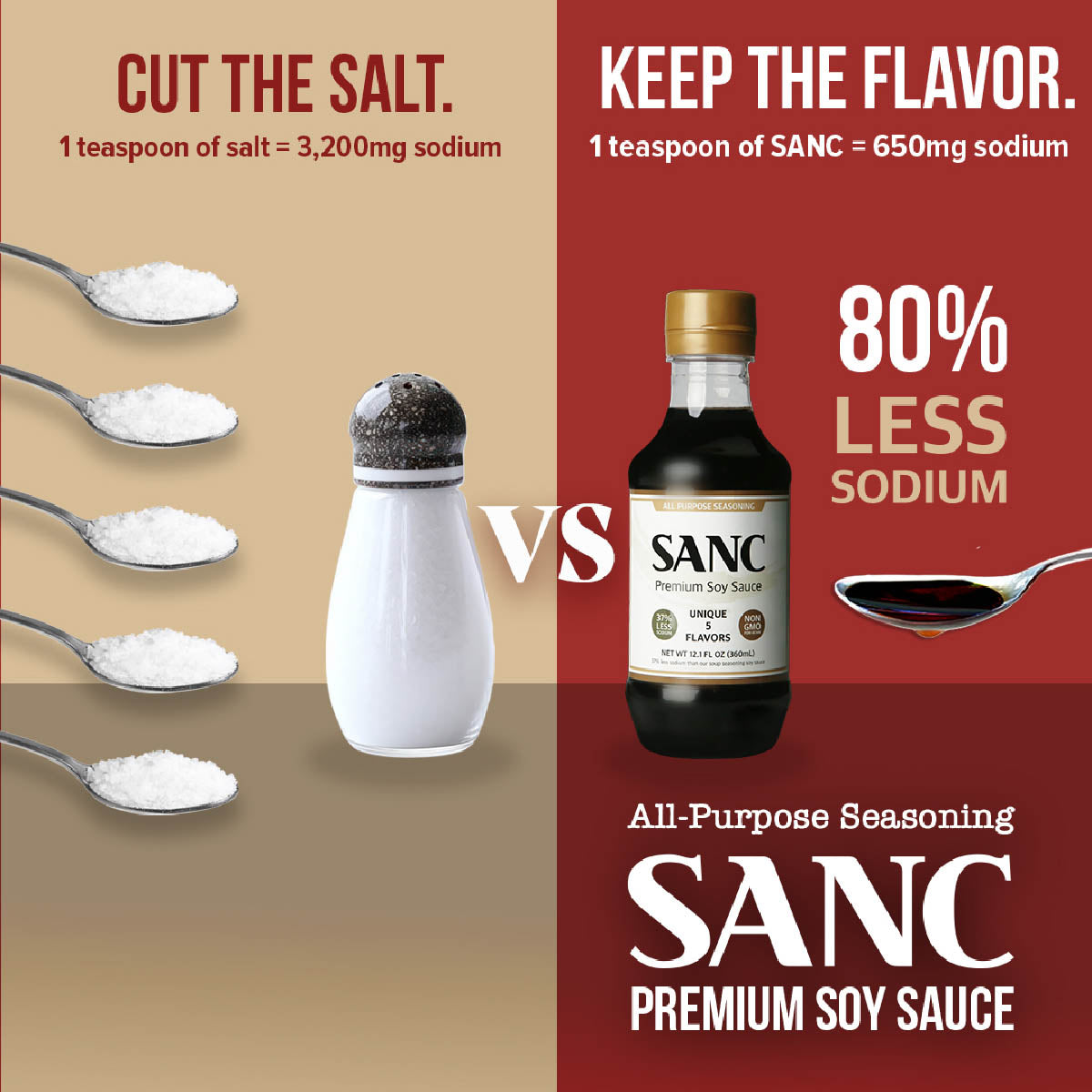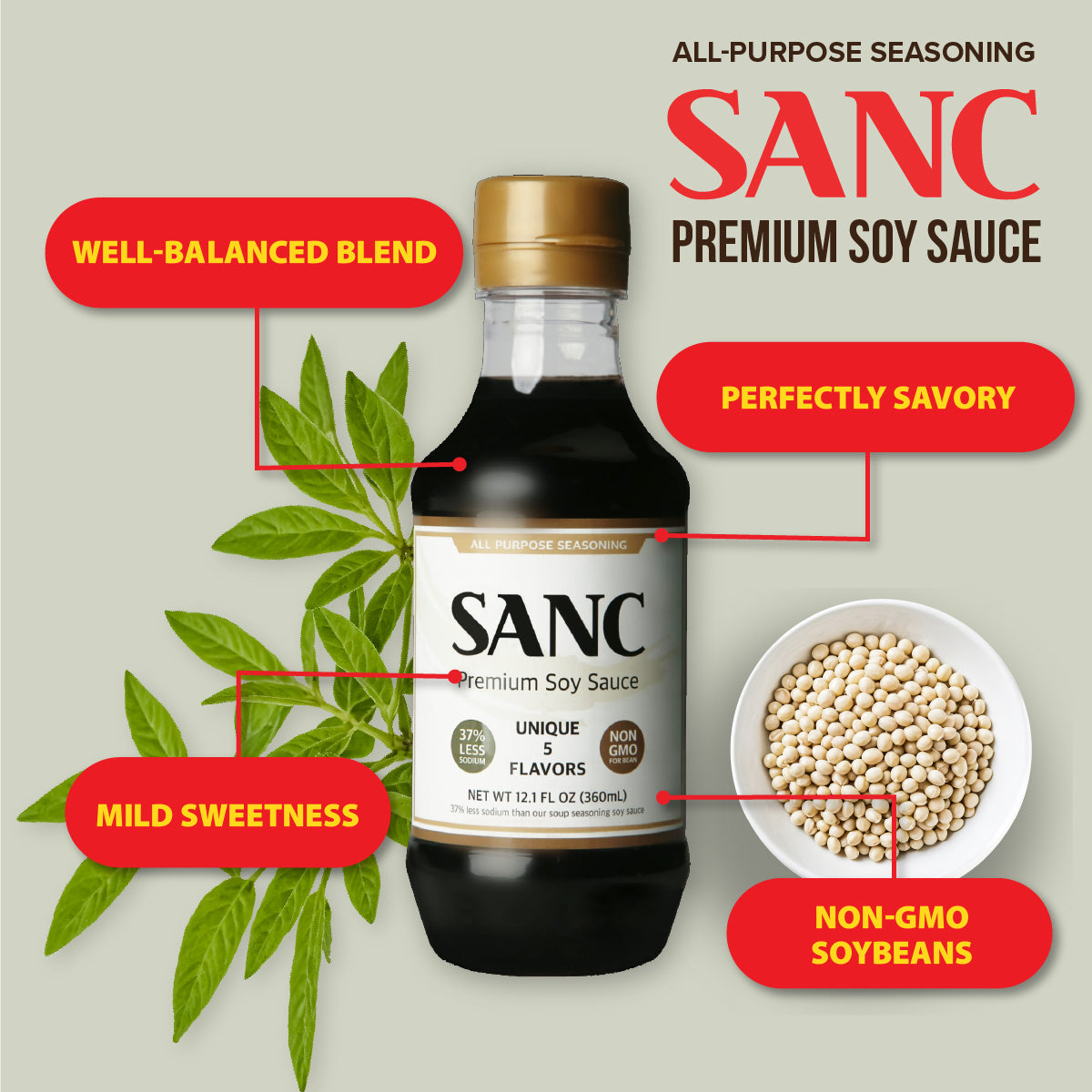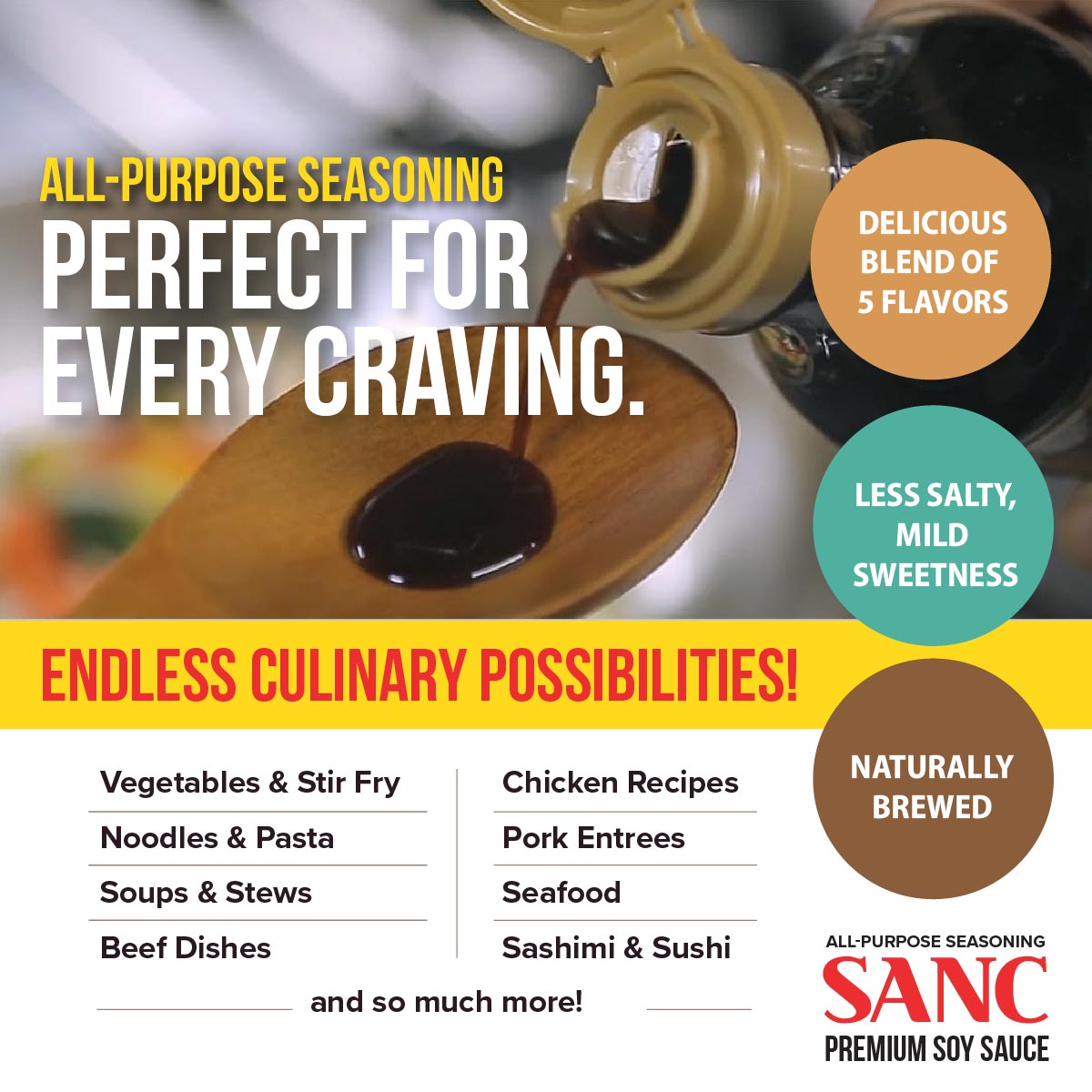SANC Premium Soy Sauce - Naturally Fermented & Aged
SANC Premium Soy Sauce
Looking to cut back on salt without sacrificing flavor? SANC Premium Low Sodium Soy Sauce has you covered. This all-purpose soy sauce lets you enjoy the rich umami taste you love with significantly less sodium. It’s a naturally brewed, fermented and aged for over 6+ months to develop deep flavor. The result is a fun, flavor-packed twist on traditional soy sauce that’s as delicious as it is healthy. Get ready to elevate your cooking with a soy sauce that doesn’t skimp on taste.
Naturally Brewed & Musically Aged for Deep Flavor
Quality is music to our ears – literally! SANC soy sauce is naturally brewed in the traditional way for 6+ months. During this time, it’s exposed to a Mozart classical music 24/7, infusing each batch with harmonious vibes. The gentle sound waves boost the activity of beneficial microbes, resulting in an naturally aged soy sauce with extraordinary depth and complexity. Every drop sings with a symphony of savory notes.
We measure our soy sauce’s greatness by its Total Nitrogen (TN) index – a key indicator of protein content and umami intensity. With a TN 1.5+ rating, SANC offers a premium fermented soy sauce that’s richer and more aromatic than typical brands. You’ll see (and taste) the difference in its dark color, enticing aroma, and bold flavor. This is craft-brewed soy sauce at its finest, where old-world aging meets a touch of musical magic for unparalleled taste.
Low Sodium, High Flavor: A Healthy Salt Substitute
SANC is not just any soy sauce; it’s a low-sodium alternative crafted to keep your meals flavorful and balanced. Traditional soy sauces contain a whopping ~900–1,000 mg of sodium per tablespoon, but SANC cuts that by about 40–50%. That means you get around half the sodium (roughly 450–600 mg per tbsp) without compromising on taste. It’s a less salty soy sauce that still delivers a satisfying savory kick.
Watching your salt intake?
This sauce is a fantastic substitute for kosher salt or table salt in your recipes. Use it to season and you’ll add layers of umami flavor while using less sodium overall. Unlike a plain potassium salt substitute (like Morton’s Salt Substitute) that only mimics saltiness, SANC Low Sodium Soy Sauce brings complex flavor to the table. It’s an ideal Morton’s salt substitute for those seeking a more natural, flavorful option. Sprinkle or splash it into your dishes as a potassium salt substitute that actually tastes delicious! From marinades to soups, a little SANC can take the place of salt and instantly upgrade your dish’s taste without overshooting the sodium.
Versatile All-Purpose Seasoning Beyond Asian Cuisine
Think soy sauce is only for stir-fries and sushi? Think again! SANC Premium Low Sodium Soy Sauce is an all-purpose seasoning that you can use far beyond traditional Asian recipes. Its well-rounded umami profile makes it a secret weapon in all kinds of cuisine. Here are just a few ideas for using this sauce to level up everyday foods:
- Eggs & Avocado Toast – Drizzle a few drops on fried eggs or avocado toast for a savory kick (way more dynamic than plain salt!).
- Burger Seasoning & Marinades – Swap out some or all of the salt in your burger mix or meat marinades with SANC to add juiciness and depth. It tenderizes and boosts flavor at the same time.
- Mashed Potatoes & Roasted Veggies – Stir a dash into mashed potatoes or toss roasted vegetables with a bit of soy sauce to enhance their natural sweetness and add a satisfying savoriness.
- Pasta Sauces & Salad Dressings – Mix into tomato sauce, gravies, or vinaigrettes for extra complexity. A splash can replace a pinch of salt, giving your sauces and dressings a richer taste.
This versatile soy sauce isn’t just for Asian cuisine – it’s a universal flavor enhancer. Whether you’re grilling, roasting, or whipping up a quick snack, a spoonful can make the difference. And because it’s lower in sodium, you can feel good about splashing it on everything from morning eggs to midnight snacks. Get creative and let SANC bring umami flavor to every bite!
Easy-Pour Soy Sauce Bottle for Mess-Free Cooking
No more drips, leaks, or over-pouring! SANC comes packaged in a thoughtfully designed soy sauce bottle that makes using it a breeze. The bottle features a leak-proof, easy-pour spout so you can drizzle or measure your sauce with precision. Shake it over your stir-fry or measure into a spoon without worrying about splatters all over the counter. The convenient design ensures you get just the right amount—every drop lands in your dish (not on your table).
Our sturdy bottle isn’t just about avoiding mess; it also keeps your soy sauce fresh. The tight cap prevents oxidation, so the flavor and aroma stay at their peak from the first use to the last. Plus, the bottle fits nicely in your hand and on your shelf, making storage simple. SANC’s packaging was created with home cooks in mind, ensuring that adding a dash of savory goodness to your meal is quick, clean, and easy.
Pure, Non-GMO Ingredients (No MSG or Preservatives)
SANC Premium Soy Sauce is as clean and natural as it gets. We start with non-GMO soybeans and wheat, honoring traditional recipes with modern quality standards. There are no artificial additives in our brew – that means no added MSG, no preservatives, and no coloring. The result is a pure, wholesome sauce you can trust. You’ll taste the difference: just pure soy sauce flavor with a smooth, clean finish. Every ingredient serves a purpose in building flavor, not just sitting on a label.







SANC 101: Everything You Want to Know
Q1: How does SANC Low Sodium Soy Sauce differ from regular soy sauce?
SANC Low Sodium Soy Sauce stands apart from regular soy sauce in a few key ways:
Naturally Brewed & Aged: It’s fermented naturally for over 6 months, whereas many regular soy sauces are brewed for a shorter time. This long aging (enhanced with Mozart music!) creates a richer, more complex flavor.
Lower Sodium: SANC contains about 40–50% less sodium than typical soy sauce. You get roughly half the salt content while still enjoying a full-bodied taste.
No Artificial Additives: Unlike some regular brands, SANC has no added MSG, no preservatives, and uses non-GMO ingredients. It’s a cleaner condiment choice.
Unique Fermentation Process: SANC uses a special Mozart Classical Music Fermentation method. Most soy sauces don’t get the luxury of musical inspiration during brewing – ours does, and it contributes to an unmatched depth of flavor!
In short, SANC offers a healthier, artisan-quality soy sauce experience without skimping on taste or tradition.
Q2: How much sodium does soy sauce contain, and how is SANC soy sauce lower in sodium?
Traditional soy sauce is quite high in sodium – about 900 to 1,000 mg of sodium per tablespoon on average. SANC Low Sodium Soy Sauce is formulated to be healthier in that regard. It delivers the same savory goodness with roughly 40–50% less sodium than regular soy sauce. That brings it down to around 600 mg of sodium per tablespoon. By using a proprietary brewing technique and careful formulation, we reduce the salt while preserving flavor. In practical terms, this means you can season your food with SANC and get plenty of salty-umami satisfaction using only half the sodium content you’d get from a standard soy sauce.
Q3: Does using less sodium affect the flavor of the soy sauce?
Not at all – in fact, you might not even notice it’s low-sodium! SANC is crafted to maintain a full, robust flavor profile despite having less salt. The extended fermentation and aging process build layers of umami that compensate for the reduced saltiness. You’ll still taste that classic savory soy sauce punch, just without the overly salty bite. Many people find SANC’s flavor indistinguishable from (or even better than) regular soy sauce, since the brewing process brings out natural richness. So, less sodium doesn’t mean less taste – your taste buds will be happy, and so will your heart health!
Q4: Can I use SANC Low Sodium Soy Sauce as a substitute for salt?
Yes! SANC Low Sodium Soy Sauce is a fantastic salt substitute in cooking. Because it’s lower in sodium than regular soy sauce (and much lower in sodium than an equivalent salty liquid like brine), you can use it in place of salt or soy sauce in recipes to reduce overall sodium. Splash it into soups, stews, sauces, or any dish that needs salt – you’ll not only be adding salinity, but also a deep umami flavor that plain salt can’t provide. It works especially well as a substitute for coarse kosher salt in marinades and rubs; plus, it brings moisture and extra flavor to the mix. Unlike using just salt, seasoning with SANC adds color and savory aroma too. Keep in mind it will introduce a bit of that soy sauce flavor (which usually enhances most dishes!). In short, you can swap salt for SANC in many cases and get more taste with less sodium – a win-win for your palate and health.
Q5: Can I use SANC Low Sodium Soy Sauce for non-Asian cooking?
Absolutely. Despite its Asian roots, soy sauce is essentially an all-purpose seasoning liquid, and SANC’s balanced taste makes it incredibly versatile for all cuisines. You can use it to enhance Western and international dishes just as easily as Asian recipes. For example, add a dash to barbecue sauce, chili, or gravy to deepen the flavor. Marinate steaks, chicken, or tofu with SANC, garlic, and herbs for a savory twist on your usual recipe. Even classics like mac and cheese or shepherd’s pie can benefit from a small spoonful of soy sauce to amp up the umami. Because SANC is lower in sodium, it’s easier to experiment with it in different foods without over-salting. So go ahead – think outside the soy sauce’s traditional role. Whether you’re whipping up Italian, Mexican, American comfort food, or anything in between, a little SANC can add that elusive “secret ingredient” taste that makes everyone ask what your cooking secret is!
Q6: Should I refrigerate SANC soy sauce after opening?
It’s recommended, yes. Soy sauce is shelf-stable due to its salt content, but for the best flavor and freshness, you should refrigerate SANC Low Sodium Soy Sauce after opening. Storing it in the fridge slows down any minor changes in flavor or color that can occur over time. If left at room temperature for long periods, an opened bottle of soy sauce may gradually darken and lose some aroma or complexity (this is true for any soy sauce). By keeping it refrigerated, you ensure that every time you reach for SANC, it tastes as bold and balanced as it did when you first opened it. Plus, a cooler environment helps preserve that rich umami character we’ve worked so hard to brew into the bottle!
Q7: Does soy sauce expire or spoil over time?
Unopened soy sauce can last for a very long time (several years) when stored in a cool, dry place. Once opened, soy sauce will not exactly “spoil” in the way milk or meat does – it won’t grow harmful bacteria or mold because of its high salt content – but it can degrade in quality over time. You might notice changes in flavor, aroma, or color after a long period. For the best taste, an opened bottle of SANC Low Sodium Soy Sauce is good for about 2–3 years when kept refrigerated. It will likely remain safe to use beyond that, but the flavor may not be as vibrant. Always make sure the cap is tightly closed. If you see any unusual sediment or off smell (which is rare), it’s time to replace your bottle. In summary, soy sauce is quite shelf-stable; SANC will stay tasty for years, especially with proper storage, but we suspect you’ll finish this delicious sauce long before it ever deteriorates!
Q8: Is SANC Low Sodium Soy Sauce gluten-free?
No, it’s not gluten-free. SANC Low Sodium Soy Sauce is brewed using soybeans and wheat (just like most traditional soy sauces), so it does contain gluten from the wheat. If you have celiac disease or a gluten sensitivity, standard soy sauce – including SANC – wouldn’t be suitable. For those who need a gluten-free option, you might consider tamari, which is a type of soy sauce made without wheat. However, tamari is not low-sodium unless labeled as such. Always check labels carefully. In the case of SANC, we prioritize a classic recipe using wheat to achieve the authentic flavor and depth, so unfortunately it’s not gluten-free. We do ensure all our wheat and soy ingredients are non-GMO and high quality, but they do contain gluten proteins.
Q9: Does SANC soy sauce contain MSG?
SANC soy sauce does not have any MSG added to it. During natural fermentation of soybeans, a small amount of glutamic acid (the G in MSG) is produced organically – this is what gives fermented foods like soy sauce or cheese their savory, umami taste. But we do not add monosodium glutamate as a separate ingredient in our sauce. Some cheaper soy sauces add MSG to boost flavor, but with SANC it isn’t necessary – our lengthy brewing process creates plenty of natural umami on its own. So if you’re avoiding MSG, you can enjoy SANC with confidence that it’s free of any artificially added MSG. The flavor you taste is coming straight from the natural brewing and aging process, nothing else.
Q10: Does it have any preservatives or artificial additives?
No, SANC Low Sodium Soy Sauce is free from artificial preservatives and additives. We don’t use any chemical preservatives like sodium benzoate that you might find in other sauces. Our brewing method and the presence of salt (even at a reduced level) act as natural preservatives. We also include a bit of naturally brewed alcohol from the fermentation to help maintain freshness – this is a traditional method to keep soy sauce stable once opened. There are no artificial colors or flavorings either. The rich color of SANC is entirely a result of the ingredients aging and fermenting over months (no caramel color added!). In short, what’s in the bottle is the pure product of brewed soybeans, wheat, salt, and a few natural sweeteners for balance – nothing more. You get authentic soy sauce, just as it was meant to be, with zero junk added.


























